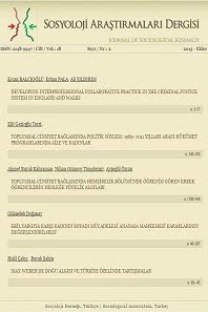Iodized Salt Usage in Turkey
Bu makalenin iki amacından ilki, Türkiye'de iyotlu tuz kullanımının yaygınlığını tahmin etmektir. İkincisi iyotlu tuzu kullanan ve kullanmayanlar için nedenleri araştırmaktır. Makalede kullanılan veriler Sağlık Bakanlığı ile UNICEF tarafından Ortaklaşa yürütülen bir projededen elde edilmiştir, iyotlu tuz kullanımının yagınlığını tahmin için ülkeyi temsil eden 12J25 hanelik bir örneklem kullanılmıştır ki bugüne kadar bu amaçla kullanılan en büyük örneklemdir. Örneklemdeki her hanede kullanılan tuz, Sağlık Bakanlığı tarafından temin edilen test kitleri kullanılarak test edilmiştir. Bu testlerin sonucu Türkiye'de hanelerin yüzde 64'nün iyotlu tuz latllandığı tespit edilmiştir. Bununla beraber iyotlu tuzun mevcudiyetine ve faydalarının bilinme derecesine gore bölgeler ve kır-kent arasında kullanımda ciddi farklar olduğu tespit edilmiştir. İyotlu tuz kullanımım tayin eden faktörleri belirlemek için kullanılan logistik regresyon analizi yaşanan yerin coğrafi bölge ve kır kent olarak önemli olduğunu, bunun yanında hanelerde yemekleri yapanların eğitimlerinin, hane büyüklüğünün ve salça yapımının iyotlu tuz kullanımını etkilediğini göstermiştir.
Anahtar Kelimeler:
iyotlu tuz, Türkiye
This paper has two aims: to estimate the iodized prevalence in Turkey and to understand reasons both for using and not using it. Data were obtained from a project jointly sponsored by the Ministiy of Health cincl UNICEF. To accomplish the first aim, study used a large representative sample of 12125 households which is the largest ever employed in the coimtiy. In each household in the sample, the salt used vim tested by tester kit provided by the Ministiy of Health. Test results indicated that 64 percent of the households used iodized salt. However, there were vast disparities in iodized salt usage among the regions and rural urban places due to availability of the iodized salt and degree of awareness of its benefits. The logistic regression analysis indicated that region which is vital for the supply and the availability of iodized salt, seems important in determining its use along with residential area as urban and rural, education, household size and tomato paste-making.
Keywords:
iodized salt, Turkey,
___
- ARSLAN P., PEICCAN, G. DERVİŞOĞLU, A. A. and others. 1 996, 15 İlde Beslenme Eğitimi ve Araştırma Projesi, Ankara.
- ATAY, K. 1935 IH. Ulusal Cerrahi Kurultayına Rapor, Kader Basımevi, İstanbul.
- CABALLERO, B and POPKIN B 2002 The Nutrition Transition: Diet and Disease in the Developing World. Academic Press: London
- CAN, G, OKTEN, A., GREEN, J. 2001 "The role of local mass media in promoting the consumption of iodized table salt", Health Education Research, Vol 16, 5:603-607.
- ERDOĞAN, M. F. and ERDOĞAN, G„ 1997 "Endemic Goiter in Turkey: Is Iodine Really Deficient", IDD Newsletter, Vol.13, 1.
- ESER, S. 1956 "Yurdumuzda Guvatr", İstanbul Tıp Fakültesi Mecmuası, Vol 19, 127-130.
- GUR, E, ERCAN, O, CAN, G, AKKUS S, GUZELOZ, S, CIFTCILI, S, AR VAS, A, and ILTER, O. 2003 "Prevalence and risk factors of iodine deficiency among schoolchildren", Journal of Tropical Pediatrics, Vol 49, 3:168- 171.
- KELLY F.C. and SNEDDEN W.W. 1960 "Prevalence and geographical distribution of endemic goiter" in WHO, Endemic Goiter, Geneva, pp. 27-333.
- KOLOĞLU S. and KOLOĞLU L. B. 1968 "Doğu Karadeniz bölgesi guatr endenıisinde tabii guatrogenlerin rolü üzerinde inceleme", Ankara Üniversitesi Tıp Fakültesi Mec¬muası, Vol 2i, pp. 419-425
- KOLOĞLU S. and KOLOĞLU L. B. 1977 "Türkiye'de endemic guvatr'in etyopatogenezi", İstanbul Tıp Ku¬rultayı Tutanakları, İstanbul
- MANNAR, M.G. VENKATESH and DUNN, John T. 1995 "Strategy for Developing a Salt Iodization Program" in Salt Iodization for the Elimination of Iodine Deficiency, Internationa] Council for Control of Iodine Deficiency Disorders.
- McKJNLAY J. B. And MARCEAU, L. D. 2000 "Upstream health public policy: Lessons from the battle of tobacco", International Journal of Health Services, 30 (l):49-69
- ONAT, A.R. 1948 X. Milli Türk Tıp Kongresi, Kader Basımevi, İstanbul.
- OZKAN, B., OLGUN, H„ CEVİZ, N., POLAT, P., TAYSİ, S., ORBAK, Z. and KOSAN, C. 2004 "Assessment of goiter prevalence, iodine status and thyroid functions in school-age children of rural Yusufeli district in eastern Turkey", Turkish Journal of Pediatry, Vol. 46, 1:16-21.
- SEMİZ, S., SENOL, U., BİRCAN, O., GUMUŞLU, S., AKCURIN S. and BİRCAN, I. 2000 "Thyroid gland volume and urinary iodine excretion in children 6-11 years old in an endemic area", Journal Pediatry Endocrinal Metab, vol. 13,3:245-251.
- SIMSEK E., SAFAK, A., YAVUZ O., ARAS S., DOGAN S. and KOCABAY It. 2003 "Sensitivity of iodine deficiency indicators and iodine status in Turkey", J Pediatr Endocrinol Metab, Vol. 16, 2: 197-202.
- UNICEF-WHO 1994 World Summit for Children- Mid-Decade Goal: Iodine Deficiency Disorders (IDD), Joint Committee on Health Policy, Special Session, Geneva.
- URGANCIOGLU, İ and HATEMİ, H. 1989 Türkiye'de Endemic Guatr, Cerrahpaşa Tıp Fakültesi, Nükleer Tıp Bilim Dalı, Yayın No. 14, İstanbul.
- USTUNDAG, Munip, HaAZNEDAROGLU D and AD üt UTLU, O. 2000 "Iodine Deficiency Disorders and Salt Iodization in Turkey", Paper presented in the World Salt Congress.
- WHO 1996 Iodine Deficiency Disorders, Fact Sheets, No. 121, htfc www.who.ch/
- WHO, UNICEF, ICCIDD 1994 Indicators for Assessing Iodine Deficiency Disorders and Their Control Through Salt Iodization. WHO, UNICEF, ICCIDD limited publication. Geneva.
- YORDAM, N., OZON, A., ALIKASIFOGLU, A., OZGEN, A., CEREN, N., ZAFER, Y. and SİMSEK, E. 1999 "Iodine Deficiency in Turkey", European Journal of Pediatry, 158:501-505.
- ISSN: 2148-9947
- Yayın Aralığı: 2
- Başlangıç: 2010
- Yayıncı: Sosyoloji Derneği
